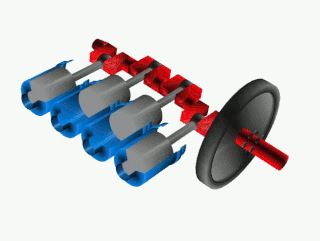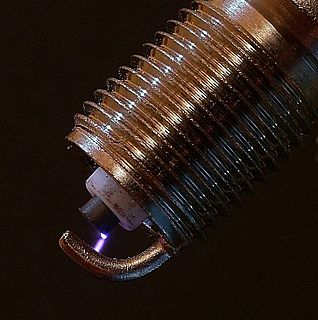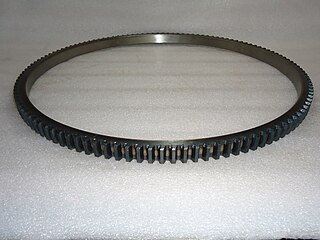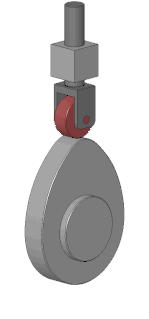 W
WIn a piston engine, the main bearings are the bearings which hold the crankshaft in place and allow it to rotate within the engine block.
 W
WIn a piston engine, the main bearings are the bearings which hold the crankshaft in place and allow it to rotate within the engine block.
 W
WA camshaft is a rotating object— usually made of metal— that contains pointed cams, which converts rotational motion to reciprocal motion. Camshafts are used in internal combustion engines, mechanically controlled ignition systems and early electric motor speed controllers. Camshafts in automobiles are made from steel or cast iron, and are a key factor in determining the RPM range of an engine's power band.
 W
WA carburetor or carburettor is a device that mixes air and fuel for internal combustion engines in an appropriate air–fuel ratio for combustion. The term is sometimes colloquially shortened to carb in the UK and North America or to carby in Australia. To carburate or carburete means to mix the air and fuel or to equip with a carburetor for that purpose.
 W
WRadiators are heat exchangers used for cooling internal combustion engines, mainly in automobiles but also in piston-engined aircraft, railway locomotives, motorcycles, stationary generating plant or any similar use of such an engine.
 W
WCore plugs, also called freeze plugs or Welch plugs, are used to fill the sand casting core holes found on water-cooled internal combustion engines.
 W
WA crankcase is the housing for the crankshaft in a reciprocating internal combustion engine. In most modern engines, the crankcase is integrated into the engine block.
 W
WA crankshaft is a shaft driven by a crank mechanism, consisting of a series of cranks and crankpins to which the connecting rods of an engine is attached. It is a mechanical part able to perform a conversion between reciprocating motion and rotational motion. In a reciprocating engine, it translates reciprocating motion of the piston into rotational motion, whereas in a reciprocating compressor, it converts the rotational motion into reciprocating motion. In order to do the conversion between two motions, the crankshaft has "crank throws" or "crankpins", additional bearing surfaces whose axis is offset from that of the crank, to which the "big ends" of the connecting rods from each cylinder attach.
 W
WA distributor is an enclosed rotating shaft used in spark-ignition internal combustion engines that have mechanically timed ignition. The distributor's main function is to route secondary, or high voltage, current from the ignition coil to the spark plugs in the correct firing order, and for the correct amount of time. Except in magneto systems and many modern computer controlled engines that use crank angle/position sensors, the distributor also houses a mechanical or inductive breaker switch to open and close the ignition coil's primary circuit.
 W
WAn electronic control unit (ECU), also known as an electronic control module (ECM), is an embedded system in automotive electronics that controls one or more of the electrical systems or subsystems in a vehicle.
 W
WAn engine control unit (ECU), also commonly called an engine control module (ECM) is a type of electronic control unit that controls a series of actuators on an internal combustion engine to ensure optimal engine performance. It does this by reading values from a multitude of sensors within the engine bay, interpreting the data using multidimensional performance maps, and adjusting the engine actuators. Before ECUs, air–fuel mixture, ignition timing, and idle speed were mechanically set and dynamically controlled by mechanical and pneumatic means.
 W
WSECU-3 is an internal combustion engine control unit. It is being developed as an open source project. Anyone can take part in the project, and can access all the information without any registrations.
 W
WAn exhaust system is used to guide reaction exhaust gases away from a controlled combustion inside an engine or stove. The entire system conveys burnt gases from the engine and includes one or more exhaust pipes. Depending on the overall system design, the exhaust gas may flow through one or more of:Cylinder head and exhaust manifold A turbocharger to increase engine power. A catalytic converter to reduce air pollution. A muffler / silencer (UK/India), to reduce noise.
 W
WA fuel filter is a filter in a fuel line that screens out dirt and rust particles from the fuel, and is normally made into cartridges containing a filter paper. They are found in most internal combustion engines.
 W
WFuel injection is the introduction of fuel in an internal combustion engine, most commonly automotive engines, by the means of an injector. This article focuses on fuel injection in reciprocating piston and rotary piston engines.
 W
WA fuel pump is a component in motor vehicles that transfers liquid from the fuel tank to the carburetor or fuel injector of the internal combustion engine.
 W
WIn internal combustion engines, the gudgeon pin connects the piston to the connecting rod, and provides a bearing for the connecting rod to pivot upon as the piston moves. In very early engine designs, including those driven by steam, and many very large stationary or marine engines, the gudgeon pin is located in a sliding crosshead that connects to the piston via a rod. A gudgeon is a pivot or journal. The origin of the word gudgeon is the Middle English word gojoun, which originated from the Middle French word goujon. Its first known use was in the 15th century.
 W
WHigh tension leads or high tension cables or spark plug wires or spark plug cables, colloquially referred to as HT leads, are the wires that connect a distributor, ignition coil, or magneto to each of the spark plugs in some types of internal combustion engine. "High tension lead" or "cable" is also used for any electrical cable carrying a high voltage in any context. Tension in this instance is a synonym for voltage. High tension leads, like many engine components, wear out over time. Each lead contains only one wire, as the current does not return through the same lead, but through the earthed/grounded engine which is connected to the opposite battery terminal. High tension may also be referred to as HT.
 W
WAn ignition coil is an induction coil in an automobile's ignition system that transforms the battery's voltage to the thousands of volts needed to create an electric spark in the spark plugs to ignite the fuel. Some coils have an internal resistor, while others rely on a resistor wire or an external resistor to limit the current flowing into the coil from the car's 12-volt supply. The wire that goes from the ignition coil to the distributor and the high voltage wires that go from the distributor to each of the spark plugs are called spark plug wires or high tension leads. Originally, every ignition coil system required mechanical contact breaker points and a capacitor (condenser). More recent electronic ignition systems use a power transistor to provide pulses to the ignition coil. A modern passenger automobile may use one ignition coil for each engine cylinder, eliminating fault-prone spark plug cables and a distributor to route the high voltage pulses.
 W
WAn intercooler is a mechanical device used to cool a gas after compression. Compressing a gas increases its internal energy which in turn raises its temperature. An intercooler typically takes the form of a heat exchanger that removes waste heat in a gas compressor. Intercoolers have a variety of applications, and can be found, for instance, in air compressors, air conditioners, refrigeration, gas turbines, and automotive engines. They are widely known as an air-to-air or air-to-liquid cooler for forced induction internal combustion engines, used to improve volumetric efficiency. This is accomplished by increasing intake air density through nearly constant pressure cooling.
 W
WThe Lucas 14CUX is an automotive electronic fuel injection system developed by Lucas Industries and fitted to the Rover V8 engine in Land Rover vehicles between 1990 and 1995. The system was also paired with the Rover V8 by a number of low-volume manufacturers such as TVR, Marcos, Ginetta, and Morgan.
 W
WThe Modular Engine Management System, or MEMS, is an electronic control system used on engines in passenger cars built by Rover Group in the 1990s. As its name implies, it was adaptable for a variety of engine management demands, including electronically controlled carburetion as well as single- and multi-point fuel injection. The abbreviations "SPi" and "MPi" refer to the single-point and multi-point injection configurations, respectively.
 W
WThe oil pump in an internal combustion engine circulates engine oil under pressure to the rotating bearings, the sliding pistons and the camshaft of the engine. This lubricates the bearings, allows the use of higher-capacity fluid bearings and also assists in cooling the engine.
 W
WA power-train control module, abbreviated PCM, is an automotive component, a control unit, used on motor vehicles. It is generally a combined controller consisting of the engine control unit (ECU) and the transmission control unit (TCU). On some cars, such as many Chryslers, there are multiple computers: the PCM, the TCU, and the Body Control Module (BCM), for a total of three separate computers. These automotive computers are generally very reliable. The PCM commonly controls more than 100 factors in a car or truck. There are many hundreds of error codes that can occur, which indicates that some subsection of the car is experiencing a problem. When one of these errors occurs, usually it will turn on the "check engine" light on the dashboard. The PCM is one of potentially several on-board computers, or essentially the "brain" of the engine control system.
 W
WRadiators are heat exchangers used for cooling internal combustion engines, mainly in automobiles but also in piston-engined aircraft, railway locomotives, motorcycles, stationary generating plant or any similar use of such an engine.
 W
WThe Rochester Ramjet is an automotive fuel injection system developed by the Rochester Products Division of General Motors and first offered as a high-performance option on the Corvette and GM passenger cars in 1957. It was discontinued partway through 1965 in favor of the Chevrolet Big Block as a performance option. Unlike electronic fuel injection systems that would become common decades later, the Ramjet is purely mechanical and relies on vacuum and pressure signals to measure airflow and meter fuel.
 W
WA rocker arm is an oscillating lever that conveys radial movement from the cam lobe into linear movement at the poppet valve to open it. One end is raised and lowered by a rotating lobe of the camshaft while the other end acts on the valve stem. When the camshaft lobe raises the outside of the arm, the inside presses down on the valve stem, opening the valve. When the outside of the arm is permitted to return due to the camshaft's rotation, the inside rises, allowing the valve spring to close the valve.
 W
WRocker covers are covers that are bolted on over rocker arms in an internal combustion engine. They are called valve covers in the United States, Canada, and in situations where Rocker Arms are not present, such as some Overhead Cam, and most Dual Overhead Cam engines. and rocker boxes in the United Kingdom.
 W
WA spark plug is a device for delivering electric current from an ignition system to the combustion chamber of a spark-ignition engine to ignite the compressed fuel/air mixture by an electric spark, while containing combustion pressure within the engine. A spark plug has a metal threaded shell, electrically isolated from a central electrode by a ceramic insulator. The central electrode, which may contain a resistor, is connected by a heavily insulated wire to the output terminal of an ignition coil or magneto. The spark plug's metal shell is screwed into the engine's cylinder head and thus electrically grounded. The central electrode protrudes through the porcelain insulator into the combustion chamber, forming one or more spark gaps between the inner end of the central electrode and usually one or more protuberances or structures attached to the inner end of the threaded shell and designated the side, earth, or ground electrode(s).
 W
WA starter ring gear is a part attached to an internal combustion engine that is part of the assembly which transfers the torque from the starter motor to the engine's crankshaft, in order to start the engine. The starter ring gear is usually made from medium carbon steel.
 W
WA tappet is most commonly a component in an internal combustion engine which converts the rotating motion of the camshaft into linear motion of the valves, either directly or indirectly.
 W
WA timing belt, timing chain, or cambelt is a part of an internal combustion engine that synchronizes the rotation of the crankshaft and the camshaft(s) so that the engine's valves open and close at the proper times during each cylinder's intake and exhaust strokes. In an interference engine the timing belt or chain is also critical to preventing the piston from striking the valves. A timing belt is usually a toothed belt—a drive belt with teeth on the inside surface. A timing chain is a roller chain.
 W
WA total-loss oiling system is an engine lubrication system whereby oil is introduced into the engine, and then either burned or ejected overboard. Now rare in four-stroke engines, total loss oiling is still used in many two-stroke engines.
 W
WA turbocharger, colloquially known as turbo, is a turbine-driven, forced induction device that increases an internal combustion engine's power output by forcing extra compressed air into the combustion chamber. This improvement over a naturally aspirated engine's power output is because the compressor can force more air—and proportionately more fuel—into the combustion chamber than atmospheric pressure alone.
 W
WA valvetrain or valve train is a mechanical system that controls the operation of the intake and exhaust valves in an internal combustion engine. The intake valves control the flow of air/fuel mixture into the combustion chamber, while the exhaust valves control the flow of spent exhaust gasses out of the combustion chamber once combustion is completed.